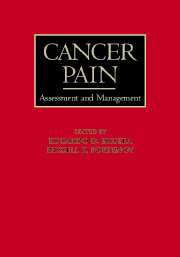Book contents
- Frontmatter
- Contents
- List of contributors
- Preface
- SECTION I MECHANISMS AND EPIDEMIOLOGY
- SECTION II ASSESSMENT AND SYNDROMES
- SECTION III PHARMACOLOGICAL TREATMENT
- SECTION IV NONPHARMACOLOGICAL APPROACHES
- SECTION V THE ROLE OF ANTINEOPLASTIC THERAPIES IN PAIN CONTROL
- SECTION VI PAIN IN SPECIAL POPULATIONS
- 18 Cancer pain management in the chemically dependent patient
- 19 Cancer pain in children
- 20 Cancer pain in the elderly
- SECTION VII DIFFICULT PAIN PROBLEMS
- SECTION VIII SPECIAL TOPICS
- Index
20 - Cancer pain in the elderly
from SECTION VI - PAIN IN SPECIAL POPULATIONS
Published online by Cambridge University Press: 08 October 2009
- Frontmatter
- Contents
- List of contributors
- Preface
- SECTION I MECHANISMS AND EPIDEMIOLOGY
- SECTION II ASSESSMENT AND SYNDROMES
- SECTION III PHARMACOLOGICAL TREATMENT
- SECTION IV NONPHARMACOLOGICAL APPROACHES
- SECTION V THE ROLE OF ANTINEOPLASTIC THERAPIES IN PAIN CONTROL
- SECTION VI PAIN IN SPECIAL POPULATIONS
- 18 Cancer pain management in the chemically dependent patient
- 19 Cancer pain in children
- 20 Cancer pain in the elderly
- SECTION VII DIFFICULT PAIN PROBLEMS
- SECTION VIII SPECIAL TOPICS
- Index
Summary
Introduction
Albert Murray, an 82-year-old English teacher writes in an Op-Ed, The Sharpest Pain, “I'm doing more than ever, but it's harder now. I'm in constant pain. But nothing hurts more like the loss of old friends. Because I look and act so energetic in spite of the pain, people think I'm about 20 years younger than I am. That includes my doctors … I tell them ‘If I felt half as good as you say I look, I'd be in excellent shape’” (1).
These concise phrases capture the critical aspects of chronic pain in the elderly. Their lives can be busy in the face of daily pain. The loss of friends and independence amplify suffering. And physicians all too commonly fail to recognize, assess and treat pain correctly (2).
Successful aging is the primary goal for the elderly and the geriatricians who care for them: an independent, good quality of life without disability. The principles and practice of palliative medicine, geriatrics, and successful pain management are quite similar. The older person and family are at the center of an interdisciplinary team structure. The clinical goals of care and autonomy are the foundation for decision making. Psychosocial and spiritual care receive respect and a good quality of life outweighs duration of survival.
The principles and guidelines for cancer pain management cited in this text hold true for the elderly who have aged successfully. It is the frail elderly who deserve a more focused pain assessment and a more individually tailored treatment. Cognitive impairment, multiple co-morbid illnesses and their treatment, and psychosocial stressors present daunting hurdles to successful pain relief.
- Type
- Chapter
- Information
- Cancer PainAssessment and Management, pp. 354 - 372Publisher: Cambridge University PressPrint publication year: 2003



